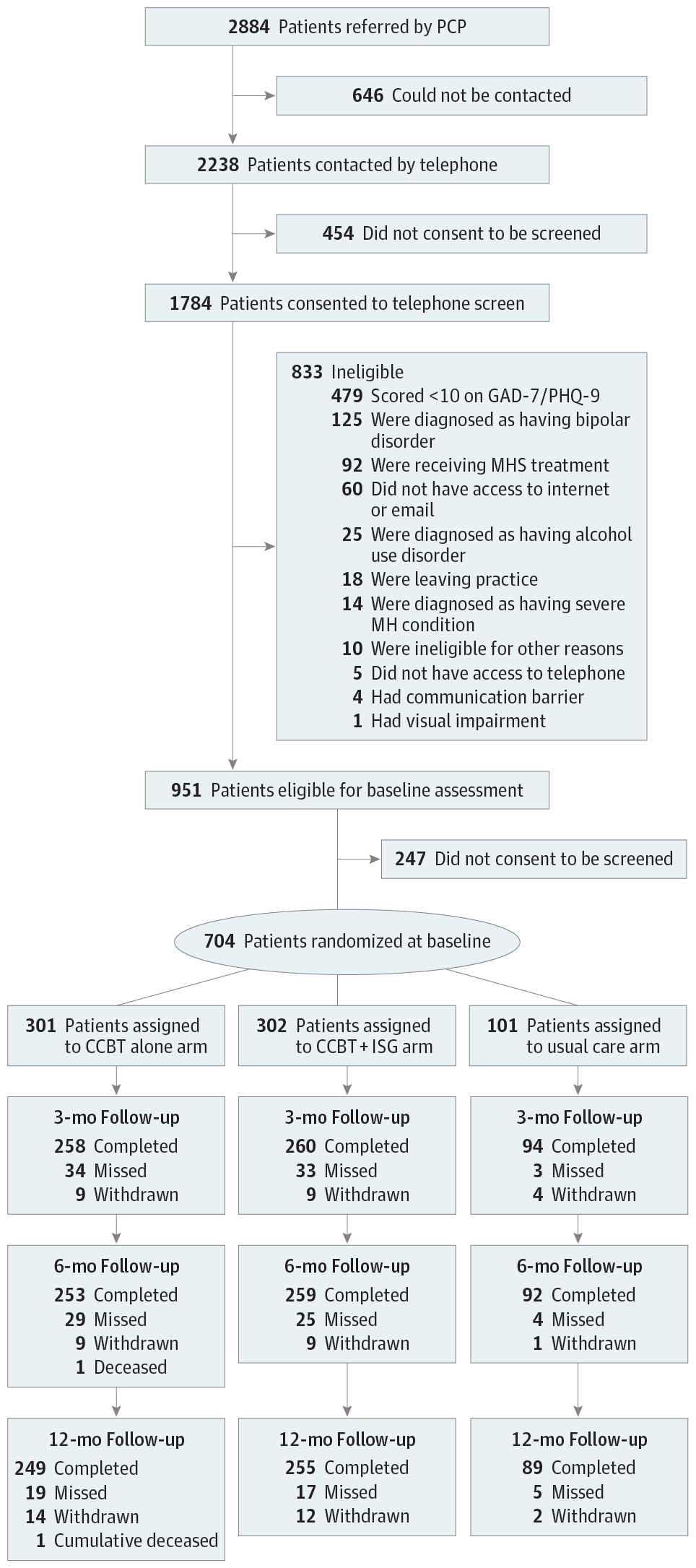JAMA Psychiatry ( IF 22.5 ) Pub Date : 2018-01-01 , DOI: 10.1001/jamapsychiatry.2017.3379 Bruce L Rollman 1, 2 , Bea Herbeck Belnap 1, 2 , Kaleab Z Abebe 1, 3 , Michael B Spring 4 , Armando J Rotondi 2, 4, 5 , Scott D Rothenberger 1, 3 , Jordan F Karp 6

|
Importance Collaborative care for depression and anxiety is superior to usual care from primary care physicians for these conditions; however, challenges limit its provision in routine practice and at scale. Advances in technology may overcome these barriers but have yet to be tested.
Objective To examine the effectiveness of combining an internet support group (ISG) with an online computerized cognitive behavioral therapy (CCBT) provided via a collaborative care program for treating depression and anxiety vs CCBT alone and whether providing CCBT in this manner is more effective than usual care.
Design, Setting, and Participants In this 3-arm randomized clinical trial with blinded outcome assessments, primary care physicians from 26 primary care practices in Pittsburgh, Pennsylvania, referred 2884 patients aged 18 to 75 years in response to an electronic medical record prompt from August 2012 to September 2014. Overall, 704 patients (24.4%) met all eligibility criteria and were randomized to CCBT alone (n = 301), CCBT+ISG (n = 302), or usual care (n = 101). Intent-to-treat analyses were conducted November 2015 to January 2017.
Interventions Six months of guided access to an 8-session CCBT program provided by care managers who informed primary care physicians of their patients’ progress and promoted patient engagement with our online programs.
Main Outcomes and Measures Mental health–related quality of life (12-Item Short-Form Health Survey Mental Health Composite Scale) and depression and anxiety symptoms (Patient-Reported Outcomes Measurement Information System) at 6-month follow-up, with treatment durability assessed 6 months later.
Results Of the 704 randomized patients, 562 patients (79.8%) were female, and the mean (SD) age was 42.7 (14.3) years. A total of 604 patients (85.8%) completed our primary 6-month outcome assessment. At 6-month assessment, 254 of 301 patients (84.4%) receiving CCBT alone started the program (mean [SD] sessions completed, 5.4 [2.8]), and 228 of 302 patients (75.5%) in the CCBT+ISG cohort logged into the ISG at least once, of whom 141 (61.8%) provided 1 or more comments or posts (mean, 10.5; median [range], 3 [1-306]). Patients receiving CCBT+ISG reported similar 6-month improvements in mental health–related quality of life, mood, and anxiety symptoms compared with patients receiving CCBT alone. However, compared with patients receiving usual care, patients in the CCBT alone cohort reported significant 6-month effect size improvements in mood (effect size, 0.31; 95% CI, 0.09-0.53) and anxiety (effect size, 0.26; 95% CI, 0.05-0.48) that persisted 6 months later, and completing more CCBT sessions produced greater effect size improvements in mental health–related quality of life and symptoms.
Conclusions and Relevance While providing moderated access to an ISG provided no additional benefit over guided CCBT at improving mental health–related quality of life, mood, and anxiety symptoms, guided CCBT alone is more effective than usual care for these conditions.
Trial Registration clinicaltrials.gov Identifier: NCT01482806
中文翻译:

在线协作治疗在初级保健中治疗情绪和焦虑障碍的有效性一项随机临床试验
重要性 抑郁症和焦虑症的协作治疗优于初级保健医生对这些情况的常规治疗;然而,挑战限制了它在日常实践中的大规模提供。技术进步可能会克服这些障碍,但尚未经过测试。
目的 检验将互联网支持小组 (ISG) 与通过协作护理计划提供的在线计算机化认知行为疗法 (CCBT) 相结合治疗抑郁和焦虑与单独使用 CCBT 的有效性,以及以这种方式提供 CCBT 是否比平时更有效关心。
设计、设置和参与者 在这项采用盲法结果评估的 3 组随机临床试验中,来自宾夕法尼亚州匹兹堡 26 家初级保健机构的初级保健医生根据 8 月份的电子病历提示转诊了 2884 名 18 至 75 岁的患者2012 年至 2014 年 9 月。总体而言,704 名患者 (24.4%) 符合所有资格标准,并随机分配至单独 CCBT (n = 301)、CCBT+ISG (n = 302) 或常规治疗 (n = 101)。意向治疗分析于 2015 年 11 月至 2017 年 1 月进行。
干预 为期六个月的 8 节 CCBT 计划的指导访问由护理经理提供,他们将患者的进展情况告知初级保健医生,并促进患者参与我们的在线计划。
主要结果和 测量 6 个月随访时的心理健康相关生活质量(12 项短期健康调查心理健康综合量表)和抑郁和焦虑症状(患者报告的结果测量信息系统),具有治疗持久性6 个月后评估。
结果 在随机分配的 704 名患者中,562 名患者 (79.8%) 为女性,平均 (SD) 年龄为 42.7 (14.3) 岁。共有 604 名患者 (85.8%) 完成了我们的主要 6 个月结果评估。在 6 个月的评估中,仅接受 CCBT 的 301 名患者中有 254 名 (84.4%) 开始了该计划(平均 [SD] 会话已完成,5.4 [2.8] 次),并且 CCBT+ISG 队列中的 302 名患者中有 228 名 (75.5%) 记录在案至少一次进入 ISG,其中 141 (61.8%) 提供了 1 个或更多评论或帖子(平均值,10.5;中位数 [范围],3 [1-306])。与单独接受 CCBT 的患者相比,接受 CCBT+ISG 的患者报告了与心理健康相关的生活质量、情绪和焦虑症状类似的 6 个月改善。然而,与接受常规护理的患者相比,单独 CCBT 队列中的患者报告了 6 个月的情绪效应显着改善(效应大小,0.31; 95% CI,0.09-0.53)和焦虑(效应量,0.26;95% CI,0.05-0.48)在 6 个月后持续存在,并且完成更多的 CCBT 课程对心理健康相关的生活质量和症状产生了更大的效应量改善.
结论和相关性 虽然提供适度的 ISG 访问在改善心理健康相关的生活质量、情绪和焦虑症状方面没有比指导性 CCBT 带来额外的好处,但单独的指导性 CCBT 比通常的治疗更有效。
试验注册 clinicaltrials.gov 标识符:NCT01482806











































 京公网安备 11010802027423号
京公网安备 11010802027423号